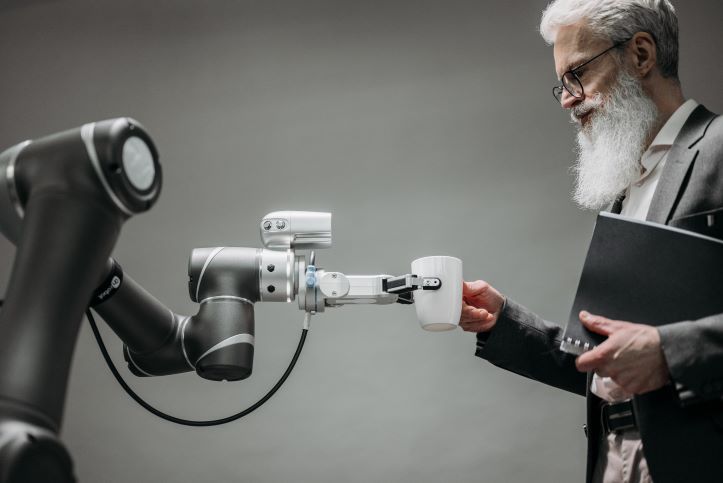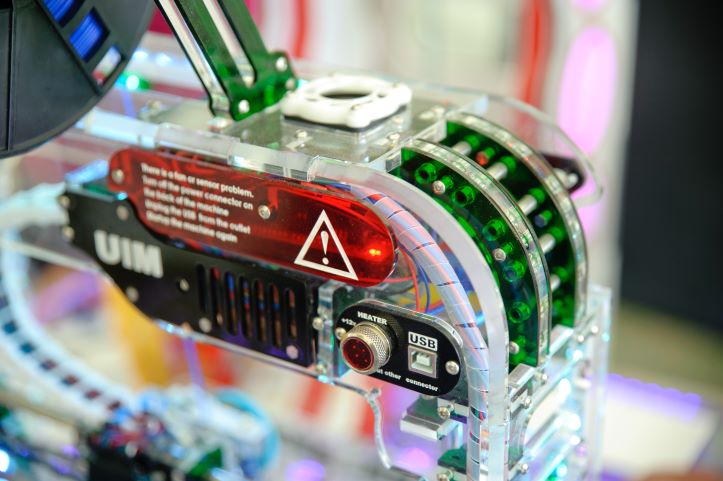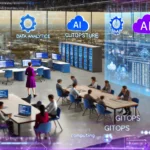If you are wondering how to deploy AI models in production, you are in the right place to learn. In recent times, the realm of technology has witnessed an unprecedented surge in the deployment of Artificial Intelligence (AI) models. As organizations embrace the power of AI, the need to effectively deploy these models has become a cornerstone of success. The ability to harness the capabilities of AI and seamlessly integrate them into business operations has transformed industries across the board.
Deploying AI models isn’t just a tech buzz; it’s a strategic move that can redefine how businesses function. With the potential to analyze massive datasets, recognize patterns, and make intelligent decisions, AI has a profound impact on efficiency, accuracy, and innovation. Industries spanning healthcare, finance, manufacturing, and more are experiencing the ripple effect of optimized processes and enhanced user experiences.
We’ll discuss production AI model deployment in this blog post. We’ll explain how AI integration works, from model selection and training to maintenance and ethics.
7 Steps on How to deploy AI models in production
# Prepare for Deployment
Before AI models take center stage, a behind-the-scenes preparation is essential to ensure a smooth deployment process. Here’s a glimpse into the crucial groundwork required:
Data Preprocessing and Cleaning
Data forms the backbone of any AI model, but it rarely arrives in a pristine state. The journey begins with meticulous data preprocessing and cleaning. This involves wrangling messy datasets, addressing missing values, and standardizing formats. The cleaner the data, the more accurate and reliable the AI model’s predictions become.
Select the Right AI Model for the Task
Choosing the perfect AI model is like picking the right tool for a job. It’s imperative to understand the problem at hand and then select a model that aligns seamlessly with the task’s requirements. Whether it’s a classification, regression, or image recognition challenge, the right model can significantly impact the deployment’s success.
Ensure Data Privacy and Security
As data becomes the lifeblood of AI, safeguarding its privacy and security is paramount. Organizations must adhere to data protection regulations and ensure that sensitive information is encrypted and anonymized. Deploying AI models in a secure environment shields both the business and its users from potential breaches.

# Infrastructure Setup
As the foundation for deploying AI models, the right infrastructure lays the groundwork for success. The first decision revolves around where to host your AI model: in the cloud or on-premises. Cloud deployment offers flexibility and scalability, while on-premises solutions provide more control over data. Consider factors such as budget, data sensitivity, and resource availability when making this crucial choice.
Hardware and Software Requirements
For a smooth deployment experience, the hardware and software setup should align with your AI model’s demands. Here are the essential requirements:
Hardware:
- Powerful GPUs or TPUs for efficient model training
- Sufficient RAM to handle large datasets
- Fast storage to minimize data access bottlenecks
Software:
- AI frameworks like TensorFlow, PyTorch, or scikit-learn
- Operating systems compatible with chosen frameworks
- Libraries for data manipulation, analysis, and visualization
Scalability Considerations for Future Growth
Planning for the future is crucial in AI deployment. Here’s what you need to consider:
Flexible Infrastructure: Choose a setup that can easily scale to accommodate increased demand.
Resource Management: Implement strategies for efficient resource allocation and utilization.
Load Balancing: Ensure even distribution of tasks to prevent overload on specific components.
Automated Scaling: Implement systems that can automatically adjust resources based on usage patterns.
# Model Training and Testing
With the foundation set, it’s time to dive into the heart of AI deployment: training and testing your model. Training an AI model is akin to teaching it to recognize patterns. This process involves feeding it vast amounts of relevant data, allowing it to learn and adjust its internal parameters. The more diverse and representative your training data is, the better equipped your model becomes at making accurate predictions.
Hyperparameter Tuning for Optimal Performance
Hyperparameters act as knobs that fine-tune your model’s behavior. Adjusting them can greatly influence how well your AI model performs. Through iterative experimentation, you can discover the ideal combination of hyperparameters that yield the best results for your specific task.
Rigorous Testing to Identify Potential Issues
Before unleashing your AI model into the real world, it undergoes rigorous testing. This phase reveals potential pitfalls and shortcomings. By simulating various scenarios and evaluating the model’s responses, you can identify issues and refine its performance before deployment.
# Integration with Existing Systems
Bringing the power of AI into the real world requires smooth integration with your existing systems. Harmonizing your AI model with existing software and databases is vital. Ensuring compatibility enables a seamless flow of information and insights. Your AI system should effortlessly interact with the tools your team already relies on, enhancing their efficiency and decision-making.
APIs (Application Programming Interfaces) and microservices act as bridges between different components of your system. By encapsulating AI functionalities into APIs, you can integrate them into your software architecture without disrupting the entire ecosystem. Microservices further enhance flexibility, allowing you to scale individual components independently.
Challenges Related to Legacy Systems
Integrating AI into legacy systems can pose unique challenges:
Data Format Variation: Legacy systems might use outdated data formats, requiring conversion.
Resource Constraints: Older systems may struggle with the resource demands of AI models.
Security Concerns: Ensuring AI doesn’t compromise existing security measures is crucial.
Lack of Expertise: Integrating AI may require skills not present in your current team.
# Monitoring and Maintenance
Deploying an AI model is just the beginning; ongoing monitoring and maintenance are essential to sustain its effectiveness. AI models, like fine-tuned instruments, need constant tuning. Real-time monitoring keeps tabs on your model’s performance, alerting you to any deviations or anomalies. By promptly addressing issues, you ensure that your AI continues to provide accurate and reliable results.
The real world is dynamic, and the data your AI model encounters will change over time. Concept drift occurs when the relationships within your data change, and data shifts happen when the distribution of your data alters. Adapting your model to handle these changes ensures its continued relevance and accuracy.
As your AI model operates in the real world, it accumulates new insights. Regular updates and retraining sessions allow it to incorporate this newfound knowledge, refining its predictions. Staying proactive in updating your model helps you stay ahead of changing trends and user behaviors.
# Ensure Ethical and Fair AI
As AI takes center stage, learning how to develop ethical Artificial General Intelligence becomes paramount. AI models can inadvertently reflect biases present in their training data. Identifying and addressing these biases is essential to prevent discrimination and unfair outcomes. Rigorous analysis of data sources and implementing techniques like re-sampling can help reduce bias and promote equitable predictions.
The inner workings of AI models can sometimes resemble a “black box,” making it challenging to understand how they arrive at decisions. Ensuring transparency by using interpretable models and providing explanations for predictions builds trust and allows users to comprehend the rationale behind AI-driven choices.
The ethical landscape of AI is regulated by various standards and regulations. Adhering to these guidelines ensures that your AI systems respect user privacy, security, and fairness. From GDPR to industry-specific regulations, compliance safeguards both your business reputation and user rights.
# User Experience and Feedback
Putting the user at the heart of AI deployment is crucial for success. User feedback is a goldmine of insights that can drive your AI system’s evolution. Encouraging users to share their experiences and suggestions provides invaluable data for refining your model’s performance and addressing pain points.
AI’s adaptability shines when it responds to user interactions. Analyzing how users engage with your AI system helps you identify areas for improvement. By fine-tuning your model based on user behavior, you create an AI that’s finely attuned to user needs.
AI doesn’t just provide predictions; it can elevate user experiences. Personalized recommendations, natural language understanding, and predictive analytics are examples of AI-driven features that enhance user engagement and satisfaction.

Case Studies
Real-world stories of AI deployment offer valuable insights into its transformative power. Let’s explore how diverse industries have harnessed AI to overcome challenges and achieve remarkable results:
Real-World Examples of Successful AI Deployment
Healthcare Revolution: AI-powered diagnostic tools are revolutionizing healthcare by rapidly analyzing medical images, aiding in early disease detection, and assisting doctors in making accurate decisions.
Financial Insights: AI’s predictive abilities are reshaping the financial sector. Fraud detection algorithms analyze transaction patterns to identify suspicious activities, protecting both institutions and customers.
Challenges Faced and Solutions Implemented
Bias in Facial Recognition: A case study in AI ethics revealed that facial recognition systems exhibited racial bias. The solution involved retraining models with diverse data sets, reducing bias and ensuring fair outcomes.
Supply Chain Optimization: An industry faced supply chain disruptions due to unpredictable events. AI-driven predictive analytics helped forecast demand and optimize inventory, mitigating the impact of disruptions.
Lessons Learned from Each Case Study
Importance of Data Diversity: The case of bias underscores the need for diverse and representative data for training models, ensuring that AI’s decisions are equitable.
Flexibility in Adaptation: The supply chain case study teaches us that AI solutions should be adaptable to changing conditions, enabling resilience in dynamic environments.
Future Trends in AI Deployment
The horizon of AI deployment is ablaze with transformative possibilities. Let’s delve deeper into the multifaceted trends that are set to shape the future:
Predictions for the Evolution of AI Deployment
Human-AI Collaboration: AI will increasingly work alongside humans, enhancing productivity by automating repetitive tasks, leaving humans to focus on creativity and complex decision-making.
Ethical AI Governance: The focus on ethical AI will lead to the establishment of comprehensive frameworks that ensure fairness, accountability, and transparency in AI systems’ behavior.
AI in Healthcare Diagnostics: AI’s ability to analyze medical data swiftly will extend to accurate disease prediction, enabling early interventions and personalized treatment plans.
Integration of AI in Various Industries
Agricultural Advancements: AI-driven precision agriculture will optimize resource usage, predicting crop health, irrigation needs, and pest outbreaks, revolutionizing the way we grow food.
Education Transformation: AI-powered personalized learning platforms will adapt to individual student needs, tailoring curriculum and pacing, fostering more effective and engaging education.
Smart Cities Revolution: Urban environments will utilize AI to enhance sustainability, managing traffic, energy consumption, waste disposal, and public services for a smarter and more efficient city life.
Technological Advancements Shaping the Future
Neuromorphic Computing: AI will increasingly mimic the human brain’s neural structure, enabling faster and more energy-efficient computation, propelling AI into realms yet unexplored.
5G and AI Synergy: The synergy between 5G networks and AI will usher in a new era of real-time data processing, enabling instant communication between devices and systems worldwide.
Robotics Redefined: AI-powered robots will become more dexterous and adaptable, paving the way for safer collaboration with humans in industries ranging from manufacturing to healthcare.
Blockchain and AI Integration: The combination of blockchain’s secure, decentralized ledgers with AI’s analytical power will create new solutions for data privacy, security, and reliable authentication.
Healthcare Personalization: AI will enable tailored medical treatments based on individuals’ genetic profiles, medical history, and lifestyle data, leading to more effective and personalized healthcare solutions.
Conclusion
In the dynamic landscape of technology, mastering the art of deploying AI models in production is a pivotal endeavor. Our journey through the intricacies of data preparation, model training, integration, and ethical considerations has revealed the essential steps for success. The ability to transform raw data into actionable insights and seamless user experiences underscores the significance of effective deployment. As industries embrace AI’s potential, the roadmap we’ve outlined stands as a guiding light.
The evolution of AI deployment isn’t merely a technical pursuit; it’s a fusion of innovation, transparency, and user-centricity. Navigating challenges, leveraging trends, and adapting to the ever-changing AI landscape pave the way for organizations to harness the full potential of this transformative technology. From its impact on healthcare and finance to reshaping smart cities, the deployment of AI models in production is a journey of continuous evolution, propelling us into a future where AI becomes an integral part of our daily lives.








